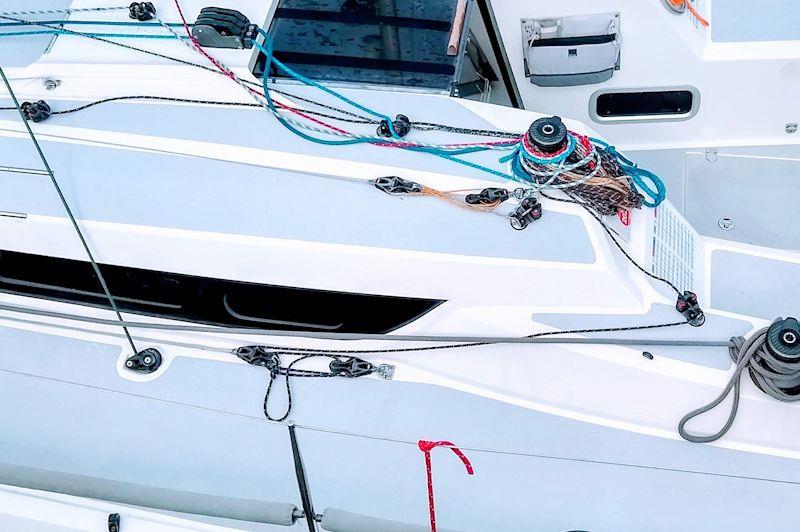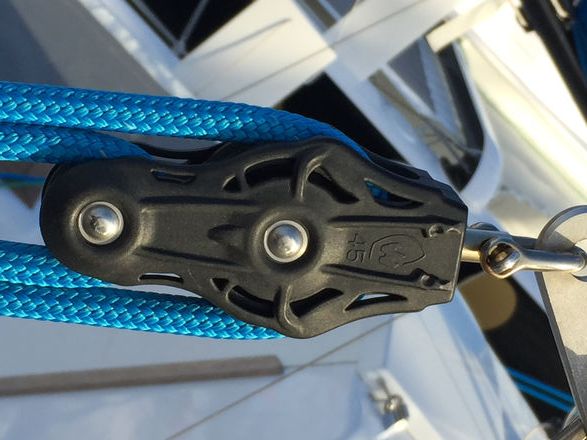
Fiddle Blocks for a low-profile purchase system
by Calanach Finlayson 16 Mar 2023 02:00 PDT

Looking at fiddle blocks © Calanach Finlayson
A fiddle or violin block is a twin-sheave block with a difference. Typically cheaper than a standard double block of equivalent size, its low profile makes it ideal for on-deck purchase systems. In this article we explore the pros and cons of fiddle blocks and where they can be put to use.
What is a Fiddle Block?
So called because of its visual resemblance to the musical instrument, a fiddle block (aka violin block) features a secondary smaller sheave in plane with the primary sheave. This is in contrast to a standard double block where two equally sized sheaves are mounted in parallel about a single axis.
Beyond that, the variants are as diverse as any block: aluminium, stainless, composite; ball bearing, roller bearing, plain bearing; fixed becket, soft becket; swivel head, lash head; cam cleat, V-cleat etc.
Fiddle Block vs Double Block?
A 4:1 purchase can be achieved with a pair of standard double blocks. One of the blocks must additionally feature a becket to terminate the line. The same system can be configured from a pair of fiddle blocks (again, one must have a becket). So what's the difference?
Let's first consider the load case. Ignoring friction and losses, each line in this system carries an equal force which is a quarter of the output force. The mechanical advantage of the system is 4:1. Therefore it appears to make sense that all sheaves should have the same size and bearing style.
However, the other effect of a mechanical advantage is the reduction of line speed throughout the system as you progress away from the input control line. Fiddle blocks take advantage of this by utilising smaller secondary sheaves, often with lower cost bearings. The result is that fiddle blocks are typically cheaper than their twin-sheave equivalents.
The following table shows a snapshot of fiddle blocks and their double block counterparts, selected at random from six different manufacturers. Note that this is not a comparison between manufacturers, but a comparison within a block range from each manufacturer.
| Model | SWL (kg) | RRP |
|---|
| Harken 40mm Carbo Air ‑ Double | 440 | € 78.55 |
| Harken 40mm Carbo Air ‑ Fiddle | 220 | € 57.00 |
| Ronstan 40mm BB Orbit ‑ Double | 500 | € 80.19 |
| Ronstan 40mm BB Orbit ‑ Fiddle | 325 | € 51.71 |
| Ubi Maior 50mm YC ‑ Double | 750 | € 152.92 |
| Ubi Maior 50mm YC ‑ Fiddle | 750 | € 152.92 |
| Antal 34mm SS ‑ Double | 400 | € 73.11 |
| Antal 34mm SS ‑ Fiddle | 400 | € 59.38 |
| Lewmar HTX 50mm ‑ Double | 800 | € 161.26 |
| Lewmar HTX 50mm ‑ Fiddle | 800 | € 123.47 |
| Wichard 45mm BB ‑ Double | 480 | € 82.00 |
| Wichard 45mm BB ‑ Fiddle | 560 | € 63.00 |
On average, a fiddle block is 20% cheaper than its double block equivalent. The catch of course is to check if the working load is not also reduced due to the smaller secondary sheave which may be a limiting factor.
But if line diameter is the key selection criteria rather than SWL, a fiddle block can be a great option. The additional benefit of fiddle blocks over double blocks is their low profile which means they present less windage, particularly if used flat on the deck.
There are of course drawbacks: Reduction in SWL is a common one. You can also expect added friction compared to a double block with two equally sized ball or roller bearing sheaves.

Applications and Summary
As we have seen, fiddle blocks are typically cheaper than their double block counterparts, sometimes for the same SWL. This makes them an attractive option for most applications where a standard double block would otherwise be used. The additional benefit of reduced windage makes fiddle blocks even more favourable for a racing boat.
Uses include:
- Vang purchase systems - either as a finished 4:1 system or in addition to cascades
- Jib inhauler or up/down control
- Running backstay or mainsheet fine tune
If you have any questions please feel free to email us at , or click the link below to see our full range:
